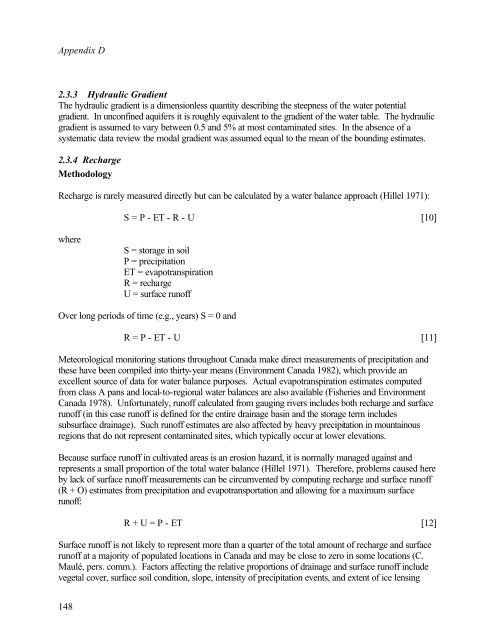Protocol for the Derivation of Environmental and Human ... - CCME
Protocol for the Derivation of Environmental and Human ... - CCME
Protocol for the Derivation of Environmental and Human ... - CCME
You also want an ePaper? Increase the reach of your titles
YUMPU automatically turns print PDFs into web optimized ePapers that Google loves.
Appendix D<br />
2.3.3 Hydraulic Gradient<br />
The hydraulic gradient is a dimensionless quantity describing <strong>the</strong> steepness <strong>of</strong> <strong>the</strong> water potential<br />
gradient. In unconfined aquifers it is roughly equivalent to <strong>the</strong> gradient <strong>of</strong> <strong>the</strong> water table. The hydraulic<br />
gradient is assumed to vary between 0.5 <strong>and</strong> 5% at most contaminated sites. In <strong>the</strong> absence <strong>of</strong> a<br />
systematic data review <strong>the</strong> modal gradient was assumed equal to <strong>the</strong> mean <strong>of</strong> <strong>the</strong> bounding estimates.<br />
2.3.4 Recharge<br />
Methodology<br />
Recharge is rarely measured directly but can be calculated by a water balance approach (Hillel 1971):<br />
S = P - ET - R - U [10]<br />
where<br />
S = storage in soil<br />
P = precipitation<br />
ET = evapotranspiration<br />
R = recharge<br />
U = surface run<strong>of</strong>f<br />
Over long periods <strong>of</strong> time (e.g., years) S = 0 <strong>and</strong><br />
R = P - ET - U [11]<br />
Meteorological monitoring stations throughout Canada make direct measurements <strong>of</strong> precipitation <strong>and</strong><br />
<strong>the</strong>se have been compiled into thirty-year means (Environment Canada 1982), which provide an<br />
excellent source <strong>of</strong> data <strong>for</strong> water balance purposes. Actual evapotranspiration estimates computed<br />
from class A pans <strong>and</strong> local-to-regional water balances are also available (Fisheries <strong>and</strong> Environment<br />
Canada 1978). Un<strong>for</strong>tunately, run<strong>of</strong>f calculated from gauging rivers includes both recharge <strong>and</strong> surface<br />
run<strong>of</strong>f (in this case run<strong>of</strong>f is defined <strong>for</strong> <strong>the</strong> entire drainage basin <strong>and</strong> <strong>the</strong> storage term includes<br />
subsurface drainage). Such run<strong>of</strong>f estimates are also affected by heavy precipitation in mountainous<br />
regions that do not represent contaminated sites, which typically occur at lower elevations.<br />
Because surface run<strong>of</strong>f in cultivated areas is an erosion hazard, it is normally managed against <strong>and</strong><br />
represents a small proportion <strong>of</strong> <strong>the</strong> total water balance (Hillel 1971). There<strong>for</strong>e, problems caused here<br />
by lack <strong>of</strong> surface run<strong>of</strong>f measurements can be circumvented by computing recharge <strong>and</strong> surface run<strong>of</strong>f<br />
(R + O) estimates from precipitation <strong>and</strong> evapotransportation <strong>and</strong> allowing <strong>for</strong> a maximum surface<br />
run<strong>of</strong>f:<br />
R + U = P - ET [12]<br />
Surface run<strong>of</strong>f is not likely to represent more than a quarter <strong>of</strong> <strong>the</strong> total amount <strong>of</strong> recharge <strong>and</strong> surface<br />
run<strong>of</strong>f at a majority <strong>of</strong> populated locations in Canada <strong>and</strong> may be close to zero in some locations (C.<br />
Maulé, pers. comm.). Factors affecting <strong>the</strong> relative proportions <strong>of</strong> drainage <strong>and</strong> surface run<strong>of</strong>f include<br />
vegetal cover, surface soil condition, slope, intensity <strong>of</strong> precipitation events, <strong>and</strong> extent <strong>of</strong> ice lensing<br />
148
















